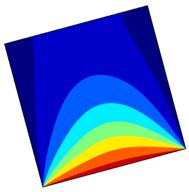Computational investigation of free convection flow inside inclined square cavities
Keywords:
Penalty finite element analysis, inclined square cavities, thermal distribution, fluid distortion, Mathematica, hybrid function, numerical integration, COMSOLAbstract
The temperature and fluid profiles of flow inside tilted square cavities are analysed with two different cases of thermal boundary conditions, (1) Isothermally cold sidewalls of the cavity and the hot bottom wall kept parallel to the insulated top wall, (2) Hot left wall, cold right wall, insulated top and bottom walls. The Galerkin finite element method with penalty parameter is used to solve the nonlinear coupled system of partial differential equations governing the flow and thermal fields. The method is further used to solve the Poisson equation for stream function. The results are presented in terms of isotherms and streamlines. The Gaussian rule with the hybrid function formed from the block-pulse function and Lagrange polynomial is implemented for the evaluation of the definite integrals present in the residual equations. Attempting to affix the hybrid methods in the integration part for solving Finite Element Method (FEM) turned efficacious as the convergence is achieved for streamlines and isotherms with the existing results. The tilted square cavities with inclination angles Deg 0 to Deg 90 and Rayleigh number ranging between 10^3 and 10^5 for Pr=0.71 (air) are investigated. The source code for the finite element analysis is written in Mathematica. The results thus obtained are found to be competent with those of COMSOL, the Software for Multiphysics Simulation.

Published
How to Cite
Issue
Section
Copyright (c) 2022 Journal of the Nigerian Society of Physical Sciences

This work is licensed under a Creative Commons Attribution 4.0 International License.





